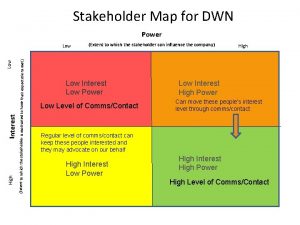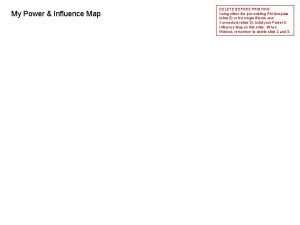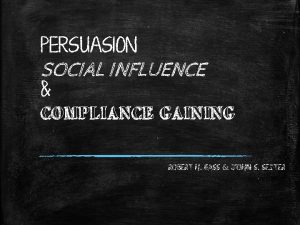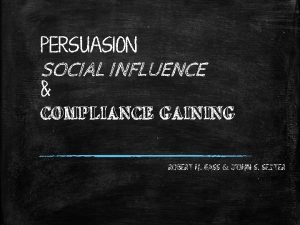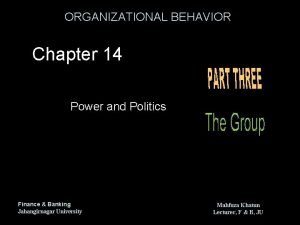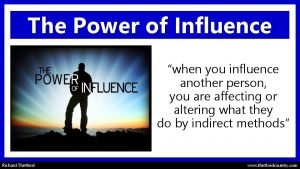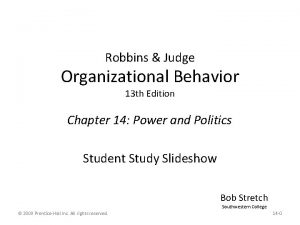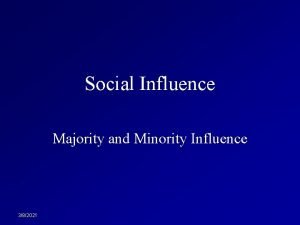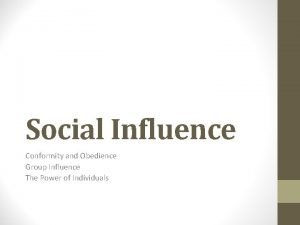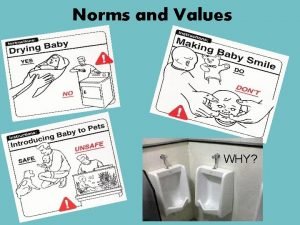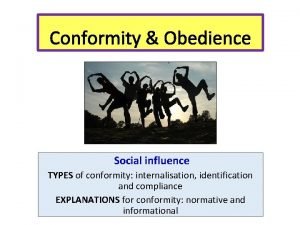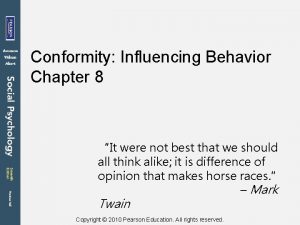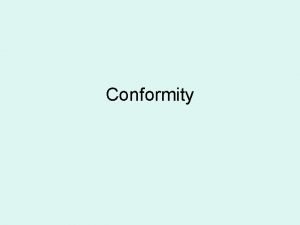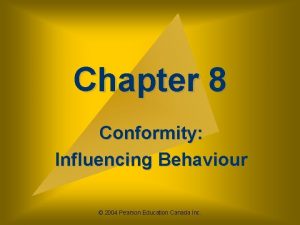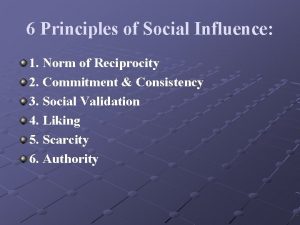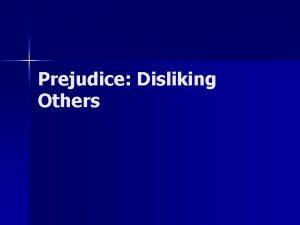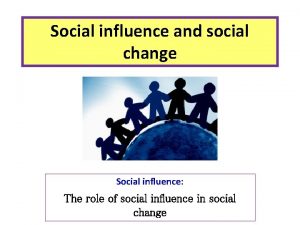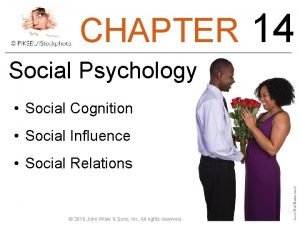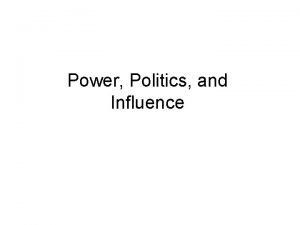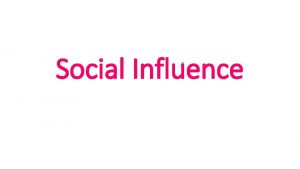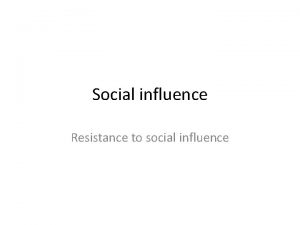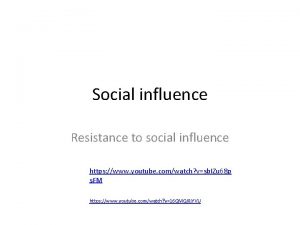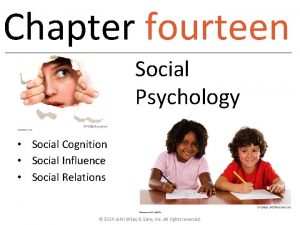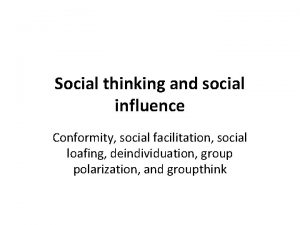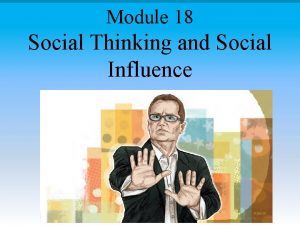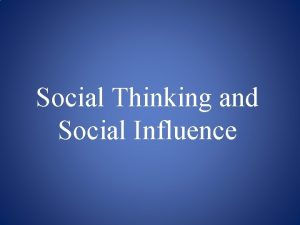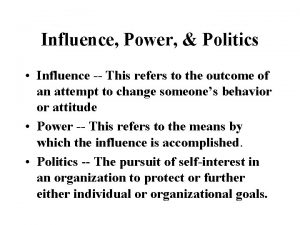Power and Social Influence Chapter 8 Amanda Zeiner
















































- Slides: 48

Power and Social Influence Chapter 8 Amanda Zeiner Courtney Brigner Chelsie Clements Ryan Groves

8. 1 Definitions of Power and Social Influence

Definitions of Power and Social Influence ● ● ● Social influence refers to attempts to affect or change other people. Conformity occurs through influence from the group. Compliance is a change in behaviors due to social pressure, but it is not a change in beliefs or attitudes. ● ● ● Power is the capacity or ability to change the beliefs, attitudes, or behaviors of others. Obedience occurs through influence from the leader of the group. Acceptance is a change in both behaviors and attitudes due to social pressure.

Why do people change because of social influence? ● ● Social psychologists provide two main reasons for the effects of social influence. Normative influence and Informational influence (Deutsch & Gerard, 1955) Normative influence refers to change that is based on the desire to meet the expectations of, and to be accepted by others. Informational influence is change that is based on accepting information from others about a situation.

The studies show. . . Dr. Solomon Asch (1907 - 1996) Dr. Stanley Milgram (1933 -1984)

Asch (1955) Conformity ● ● ● Conformity study that showed even when group pressure is merely implied, people are willing to make bad judgements. Participants were asked to select which line was the same length as a target line. Participants who worked alone rarely made mistakes. However, participants who were in a room with people giving the wrong answers made mistakes 37% of the time. Only 20% of the participants in the room with others remained independent and did not give in to group pressure. Those that did conform did so without obvious pressure existing (no rewards/punishment).

Milgram (1974) Obedience ● ● ● Obedience study that showed people are obedient to authority figures even when the requested behaviors are inappropriate. Participants believed they were part of a learning experiment and were asked to give an electric shock to a learner whenever the learned made a mistake. After each mistake, the participants were asked to increase the level of shock with each mistake. Nearly all the participants were willing to administer mild shocks. 65% of them, continued to administer shocks even after the learned had stopped responding and they believed that the shocks being administered had increased to dangerous levels.

Milgram (1974) continued. . . ● ● ● The level of obedience in these studies was influenced by several factors. The more legitimate the authority figure, the more likely people were to be obedient. They were more likely to obey when the authority figure was in the room monitoring their performance.

Milgram Cont. ● ● ● Whenever possible, participants did not administer a shock to the learner and then lied to the authority figure about their actions. The more that participants could see or hear the victim’s pain, the less obedience there was. The important finding in the Milgram studies is that obedience occurs even when the authority figure does not have power to reward or punish participants.

8. 2 Types of Power

Types of Power ● ● ● Team members sometimes use various types of power to influence each other and the team. The study of bases of power is about the sources of power; personal/soft power or positional/harsh power. The study of influence tactics is how various power tactics are used.

Bases of Power Two types of power ● Personal (Soft Power) ○ Derives from the individual's characteristics and personality ○ Includes expert, referent, and informational power ● Positional (Harsh Power) ○ Derives from the individuals formal position in an organization ○ Includes legitimate, reward, and coercive power

Personal (Soft power) ● ● Expert: Power based on one’s credibility or perceived expertise in a specific area ○ People tend to use this type of power most often because individuals are less likely to oppose this type of power ○ It can also be an employee who knows how to do something the manager does not Referent: Power based on another’s liking and admiration ○ Inspire others to be committed to their jobs ○ An example of this type of power is a celebrity news or gossip.

Personal (Soft Power) ● Information: Power based on the knowledge or information one has about a topic ○ Give away a piece of your information and you give away this type of power ○ This type of power does not last forever Build expertise and reward people

● Positional (Harsh Power) ● Legitimate: Power based on the recognition and acceptance of a person’s authority. ○ The position held gives them this power, if you lose the position, your power decreases ○ CEO, president, or monarchs ○ This type of power does not automatically make you a good leader Reward: Power based on the ability to reward (reinforce) a desired behavior. ○ Bonuses, pay raises, extra time off, recognition, and praise. ○ Encourages employees to work harder ○ Some employees may feel less inclined to work hard if they are not being recognized

Positional (Harsh Power) ● Coercive: Power based on the ability to threaten or punish undesirable behavior. ○ This type of power forces employees to do a task in fear they may lose something such as a bonus or their position ○ This can be useful if there is an employee who is consistently late for work, the leader could threaten the employees bonus

Bases of Power ● ● ● The types of power are related to each other and are used together ○ Example: If someone has more legitimate power, then the more reward and coercive power one has as well. Teamwork will occur when personal power is being used, rather than positional power. Cooperation and decision making will be improved when using personal power

Influence Tactics ● Team members use a variety of social influence tactics to change one another ○ Rational argument, consultation, inspirational appeals, personal appeals, ingratiation, exchange, pressure, legitimizing tactics, and coalition tactics. ○ Vary by directness, cooperativeness, and rationality.

Types of Tactics ● ● Direct tactics are explicit, unconcealed methods of influence (Personal appeal and pressure). Indirect tactics conceal attempts at manipulation (Ingratiation and coalition tactics). ○ Cooperative tactics encourage support through rational argument or consultation. ○ Competitive tactics attempt to deal with resistance through pressure or ingratiation. ○ Inspirational and personal appeals rely on emotion.

Social Influence Tactics ● ● Rational Argument: ○ Using logical arguments and factual information to persuade someone. Consultation: ○ Seek a person’s participation in the decision. Inspirational Appeals: ○ Attempt to arouse enthusiasm by appealing to a person’s ideals. Ingratiation: Use flattery or friendly behavior to get a person to think favorably of you.

Social Influence Tactics ● ● Exchange: ○ Offer to exchange favors later for compliance now. Pressure: ○ Uses demands, threats, or persistent reminders. Legitimizing Tactics: ○ Makes claims that one has the authority to make the request. Coalition Tactics: ○ Seek the aid and support of others to increase power of request.

Social Influence ● ● People prefer direct and cooperative strategies. ○ The most effective tactics are rational argument, consultation, and inspirational appeals. ○ More socially acceptable and are useful in most situations. Traditional leaders often use pressure and legitimizing tactics to influence subordinates. Subordinates usually lean towards rational argument, personal appeals, and ingratiation to influence others. Team leaders have less power than managers so they are more likely to use cooperative tactics.

8. 3 Power Dynamics

The use of power changes the dynamics of the group process Example: unequal power changes the way the leader treats other team members and the way members communicate with one another The level of interdependence among team members changes the power they have over one another

Effect of Power ● ● ● Power is so rewarding that people want more of it Corrupting influence People with more of it give themselves a higher share of rewards Easier for someone with power to give commands than make requests Care less about what subordinates say Inflated view of their own worth

Cycles of Power ● ● ● Access to power increases the probability that it will be used The more power is used, the more power holders believe they are in control As power holders take more credit, they view the target as less worthy As the target’s worth is decreased, social distance increases Use of power self elevates the selfesteem of the powerful

When leaders know that they will eventually become just another team member, they are less likely to use controlling power tactics

Unequal Power in a Team Unequal power levels among members creates mistrust, less communication, and more social problems Teams with powerful leaders tend to have less communication and more autocratic decision making - reducing the quality of team decisions

Status Differences High Status ● ● ● Members talk more and address the whole team Leaders have lower opinions of other team members’ communications, less willing to look at others’ perspectives, less likely to listen to others Team members communicate more with high status people and pay more attention to what they say Low Status Members talk less because their contributions are not valued Unwilling to state their opinions if they differ from high status people - they either agree or say nothing

Women in Teams Tend to experience a “backlash effect” from engaging in high status displays (speaking for longer, taking charge, etc. ) based off gender hierarchies, are reserved for men May purposely speak less to prevent the backlash effect threatening their ability to attain positions of power and status EX: while high-power men tend to speak more, high-power women speak as much as low-power woman and low-power men

How to Prevent Unequal Power: Members should leave their external status positions at the door It is difficult when you’re supposed to interact as equal in one situation and be differential with said person in other situations Try to improve the situation by using team norms to equalize power and control communication

Minority Influence ● ● ● Ability of minorities to influence the majority group depends on: ○ Consistency ○ Self-Confidence ○ Belief in their autonomy ○ Relationship to their group If viewed as supported or influenced by an outside group, impact is reduced MUST appear to be apart of a team

Impact of Interdependence Task interdependence - the degree to which completing a task requires the interaction of team members. Teams with HIGH levels of interdependence are more likely to be effective if they have autonomy or the power and authority to control how they operate Autonomy allows teams to work together more efficiently, control their own interactions, and increase internal coordination = Improved performance when team faces uncertainty

8. 4 Empowerment

Empowerment ● ● Empowerment in a workplace refers to the process of giving employees more power and control over their work. It is also shifting power and authority from managers to employees. Empowerment is also the core notion of teamwork. This element makes a team different from a work group.

Empowerment and success ● ● The success of empowerment programs depends on an organization’s willingness to share information and power with its employees. Success is related to an organization’s structure and culture. Delegating authority is stressful for managers because their companies tend to hold them responsible for team’s outcome. One of the main problems with empowerment programs is resistance from managers and supervisors.

Individual vs team empowerment ● ● Team ○ The delegation of authority or responsibility to the team Individual ○ Team members accept responsibility and are given the ability to make their own decisions and solve problems.

What empowerment does to employees ● ● ● Increases motivation Increases sense of responsibility Gives them confidence in their ability to perform a task Increase engagement (commitment and dedication) Provides better customer service More effective team performance

Degrees of Empowerment Programs ● ● ● The amount of empowerment that a team has depends on: ○ The actions of their leaders ○ The responsibilities ○ Human resource practices ○ Social structure Organizations use a variety of activities to promote empowerment ○ Suggestion boxes ○ Work eams ○ Self-managing teams Most empowerment programs give teams control over job context like goals or reward systems.

What supervisors need to do to promote empowerment ● ● ● Share information and power your employees Trust and respect Give them authority and control Let them make decisions Let them set their own performance goals and how to accomplish them Be involved in the design of your empowerment program

8. 5 Application: Acting Assertively

Application: Acting Assertively ● ● People express power through their behaviors. Assertiveness is a skill and an attitude. When team members act assertively, they show their willingness to be independent and accept responsibility for their actions. Power Styles have an important impact on communication in teams.

● Power Styles ● ● Passive ○ Polite and deferential ○ Avoid problems ○ Desire to be liked by others ○ Goal to win approval and acceptance Aggressive ○ Forceful, critical, and negative ○ Emotions include anger, insecurity, and lack of trust ○ Acts forcefully in all situations Assertive ○ Clear and confident communication ○ Goal to find the best situation so the other person is willing to listen and compromise ○ Shows respect, encourages others, and inspires open communication.

Use of power styles ● ● Teams are more productive when their communication is primarily assertive. Assertiveness is used among people with relatively equal power. Passiveness and aggressiveness are used among people with differing levels of power. Rarely true, differences in power styles are often related to personality, gender or racial differences and get in the way of improving teams.

Encouraging assertiveness ● ● ● The best way to encourage assertiveness is to equalize power among team members. Assertiveness training programs use a number of techniques to encourage better communication such as: ○ Active listening ○ Positive recognition ○ Clear expectations ○ Assertive withdrawal It is important to have assertiveness training where team members need to apply assertive behavior.

● Team Leader Challenge ● ● You are the manager of a technical services team that provides support services for other organizations. Over the past year, you have been trying to make the transition to a more selfmanaging team. For instance, you now call yourself the “team leader” rather than the manager. As part of the transition, the team now makes decisions about scheduling, partnering, and other task assignments. Team meetings where employees passively listen to instructions have been replaced by team discussions and group decision making. You have worked hard and encouraged team members to speak up at meetings, and they are not contributing more.

Team Leader Challenge ● At today’s meeting, a team member suggested a new way to organize work practices. ● You told the team you didn’t like the idea because you had tried a similar plan in the past and it did not work well. ● Another team member ignored your explanation and complained that you were stifling innovation and were unwilling to share power with the team

Team Leader Challenge Questions As a team, answer these questions based on the information given ● How can you (the team leader) respond to a “bad” idea without discouraging team participation? ● What is the best way to handle team members who challenge the leader’s authority? ● What norms could be adopted to help the team communicate more effectively? ● How much power sharing (or empowerment) is appropriate for a work team?
 Social thinking and social influence
Social thinking and social influence Social thinking social influence social relations
Social thinking social influence social relations Social thinking and social influence
Social thinking and social influence Social thinking and attribution theory
Social thinking and attribution theory Triangle of power
Triangle of power Stakeholder mapping
Stakeholder mapping Power and influence mapping
Power and influence mapping Influence map template
Influence map template Power and influence matrix
Power and influence matrix Power and influence in the workplace
Power and influence in the workplace Passivity
Passivity Group dynamics and communication
Group dynamics and communication Communication persuasion paradigm
Communication persuasion paradigm Robert h gass persuasion download
Robert h gass persuasion download Power as a corrupting influence in dr. faustus
Power as a corrupting influence in dr. faustus Illegitimate political behaviour
Illegitimate political behaviour Power of influence
Power of influence Preferred power tactics by influence direction
Preferred power tactics by influence direction Preferred power tactics by influence direction
Preferred power tactics by influence direction Normative social influence
Normative social influence Conversion social influence example
Conversion social influence example What is informational social influence in psychology
What is informational social influence in psychology Examples of informational social influence
Examples of informational social influence Values and norms examples
Values and norms examples What is normative influence
What is normative influence What is informational social influence in psychology
What is informational social influence in psychology Informational influence
Informational influence Informational social influence
Informational social influence Informative conformity example
Informative conformity example Maximizing the spread of influence through a social network
Maximizing the spread of influence through a social network Maximizing the spread of influence through a social network
Maximizing the spread of influence through a social network Social influence theory of hypnosis
Social influence theory of hypnosis Example of social influence
Example of social influence Social influence principles
Social influence principles Unit 14 social psychology
Unit 14 social psychology Divided consciousness theory of hypnosis
Divided consciousness theory of hypnosis Example of social influence
Example of social influence 2-2 creating and solving equations
2-2 creating and solving equations Solar power satellites and microwave power transmission
Solar power satellites and microwave power transmission Actual power and potential power
Actual power and potential power The dispersive power of grating increases with increasing
The dispersive power of grating increases with increasing Chapter 12 section 1 china resists outside influence
Chapter 12 section 1 china resists outside influence Chapter 19 the increasing influence of europe
Chapter 19 the increasing influence of europe Compare and contrast social darwinism and social gospel
Compare and contrast social darwinism and social gospel Nature and power of prejudice in social psychology
Nature and power of prejudice in social psychology Ucam biblioteca
Ucam biblioteca Amanda wingfield
Amanda wingfield A little silver slipper of a moon
A little silver slipper of a moon Tarzwell law
Tarzwell law





